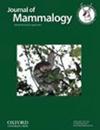栖息地引起的高原鼠兔饲料质量变化及其对适应性的影响
IF 1.6
3区 生物学
Q2 ZOOLOGY
引用次数: 0
摘要
高原鼠兔(Ochotona curzoniae)在青藏高原(QTP)的高山草甸生态系统中发挥着重要作用。几十年来,青藏高原草地出现了一定程度的退化,这主要是由于大量放牧造成的。与此同时,由于草原退化改变了植被群落结构和优势物种,植物营养成分向有利于高原鼠兔的高蛋白方向转移,高原鼠兔的数量也急剧增加。大量研究支持这样的假设,即食物的数量和质量限制了食草动物的数量。在这里,我们通过野外调查研究了高原鼠兔食物中必需氨基酸的可用性与牲畜放牧强度造成的草地退化程度之间的关系,并通过实验室饲喂含 0.26% 和 0.45% 蛋氨酸的两种颗粒饲料实验研究了个体的适应性。含硫蛋氨酸和胱氨酸是鼠兔日粮中最主要的限制性氨基酸。在鼠兔繁殖季节,大部分必需氨基酸的浓度,尤其是蛋氨酸和胱氨酸的浓度,在严重退化的草地上高于轻度和中度退化的草地。与喂食 0.26% 蛋氨酸的个体相比,喂食 0.45% 蛋氨酸的个体细胞介导免疫力增强,球虫感染强度降低,促性腺激素释放激素、黄体生成素、雌二醇、孕酮和睾酮的浓度增加。这些结果表明,严重退化的草地提供了相对优质的食物,提高了个体的适应能力,这表明严重退化草地中的高蛋氨酸食物可能是高原鼠兔产生和维持高密度种群的关键因素。本文章由计算机程序翻译,如有差异,请以英文原文为准。
Habitat-induced changes in forage quality and implications for fitness in Plateau Pika (Ochotona curzoniae)
Plateau pikas (Ochotona curzoniae) play a keystone role in the alpine meadow ecosystem on the Qinghai–Tibetan Plateau (QTP). For decades, QTP grasslands have become degraded to some degree, largely as a result of heavy livestock grazing. Concomitantly, the abundance of plateau pikas has increased dramatically as grassland degradation has altered the vegetation community structure and dominant species, shifting the plant nutrient contents toward higher protein conditions that favor them. Considerable research supports the hypothesis that the quantity and quality of food limit herbivore populations. Here, we examined the relationship between the availability of essential amino acids in the diets of plateau pikas and the degree of meadow degradation associated with livestock grazing intensity through a field survey, as well as the fitness of individuals by laboratory feeding experiments with 2 pelleted chows containing 0.26% and 0.45% methionine. Sulfur-containing methionine and cystine were the most limiting amino acids in the diets of pikas. During the pika breeding season, the concentrations of most essential acids, particularly methionine and cystine, were higher in heavily degraded meadows than in lightly and moderately degraded meadows. Individuals fed 0.45% methionine exhibited enhanced cell-mediated immunity, reduced intensity of coccidian infection, and increased concentrations of gonadotropin-releasing hormone, luteinizing hormone, estradiol, progesterone, and testosterone compared to those fed 0.26% methionine. These results showed that heavily degraded meadows provided relatively high-quality food that improved individual fitness, suggesting that the high-methionine food in the heavily degraded meadows may be a key factor in the generation and maintenance of high-density populations of plateau pikas.
求助全文
通过发布文献求助,成功后即可免费获取论文全文。
去求助
来源期刊

Journal of Mammalogy
生物-动物学
CiteScore
3.30
自引率
5.90%
发文量
106
审稿时长
4-8 weeks
期刊介绍:
Papers are published on mammalian behavior, conservation, ecology, genetics, morphology, physiology, and taxonomy.
 求助内容:
求助内容: 应助结果提醒方式:
应助结果提醒方式:


